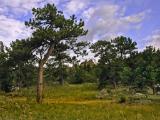 © Mike Norton (Colorado)
© Mike Norton (Colorado)

Ponderosa Pine
Ponderosa pine systems are found on rolling plains, plateaus, or dry slopes (usually on more southerly aspects). This system is best described as a savanna that has widely spaced (>150 years old) Ponderosa pine trees. Healthy Ponderosa pine stands often consist of open and park-like stands of trees, with an understory of predominantly fire-resistant grasses and forbs. Older trees drop their lower branches as they age, thus protecting them from ground fires. Young Ponderosa pines have brownish bark, while old-growth Ponderosa pines have yellow bark—in fact, the common name for this tree was once "yellow pine." Many people enjoy the butterscotch or vanilla scent common in exposed Ponderosa pine bark.
The most significant ecological process in maintaining this system is fire, characterized by frequent, low-intensity ground fires. In stands where the natural fire regime still occurs, shrubs, understory trees and downed logs are uncommon. However, a century of human development and fire suppression (primarily to protect people's homes) has resulted in a higher density of Ponderosa pine trees. In a naturally functioning fire regime, periodic ground fires kill only the younger trees. The wide spacing of mature trees prohibits or reduces the occurrence of crown fires (the only kind that usually kill mature Ponderosa pine). When fires are not allowed to burn, young trees continue to grow and places that were once open savannas and woodlands become dense forests. With the increased density of trees that is now common in Ponderosa pine ecosystems, fires can easily reach the crown, potentially killing the entire forest patch. Presently, many Ponderosa pine stands contain understories of more shade-tolerant trees, such as Douglas fir, as well as younger Ponderosa pine saplings.
Rarity in the Ponderosa Pine System
The most notable species of concern in Colorado's Ponderosa pine ecological system is the federally threatened Pawnee montane skipper butterfly. This species occurs only in Ponderosa pine systems with an understory of blue grama grass (its host plant). In Colorado, Grace’s warbler is only known from Ponderosa pine stands in southwestern Colorado..
Conservation
The Ponderosa pine ecological system is among Colorado's ecosystems most in need of conservation. It is considered weakly conserved by the Colorado Natural Heritage Program and The Nature Conservancy, and is listed as a Priority Habitat in the State Wildlife Action Plan. Many stands have been lost to urban development, and many of the remaining stands are in degraded condition. The likelihood of threats (primarily development and fire suppression) continuing into the future is high, and Ponderosa pine is not well represented in our state's system of protected areas. To access Colorado's Biodiversity Scorecard click here. To access Colorado's State Wildlife Action Plan click here.





